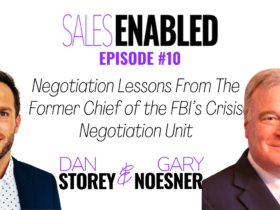How good is your sales training program? Most companies have sales training teams, but how effective are they at serving the needs of the business? Aside from having great internal feedback and positive comments from people that attend the program, or new hires joining the business, how can you really tell if a sales training team is performing?
Ideally, your sales training team should be a good combination of selling experience mixed with learning and development understanding. The sales experience will give them credibility in front of their attendees, but it will actually be the L&D side of their experience that will help them highlight their impact on the business.

The model that good sales trainers refer to when asked if they are making an impact is the Kirkpatrick Learning Model. The Kirkpatrick Model assesses learning over 4 levels, ranging from the most superficial level of the initial reaction to a training session, all the way through to tracking changes in results that occur after a training program.
Let’s take a quick look at what each of these levels mean, and how sales training should be thinking about them.
Level 1 – Reaction
What sort of questions do you ask on your training feedback forms? Did this training meet your expectations? Did the trainer seem knowledgeable about the subject matter? Getting good scores on your feedback forms may make you a good facilitator, but how much of an impact does a great review have on the business? If this is the only way you are measuring your impact as a sales trainer, you definitely need to think about measuring your impact further through the Kirkpatrick Learning Model.
Level 2 – Learning
During your training session, did you share some new information? If you are going to be taking salespeople off the floor, then you better be using that time wisely. So how do you know if the information you shared was retained by your delegates? Using some kind of learning assessment, such as a multiple choice test, is a great way to ensure that the information has been effectively communicated. If you send this test out a few weeks after the training, you will also be able to tell if it was retained. However, there are many situations in which we know what do do, but don’t necessarily do it. Your next challenge is to figure out if this new knowledge had an impact.
Level 3 – Behaviour
Sales is a numbers game. The challenge is measuring the right numbers. All sales training should aim to change some form of sales behaviour. Cold call training should make people make more calls, or handle objections more effectively to keep prospects on the phone. Qualification training should help the salespeople get better information they can use in their sales process by teaching them to ask better questions. What is the behaviour you will measure to see if your training has been effective? Think about how you align your sales training with manager scorecards to get measurable data on the impact of your training.
Level 4 – Results
Ultimately, the only reason you would train someone is to help them get better results. Ideally, all training should be attached to a particular business metric. For example, how would you measure the effectiveness of a negotiation training? A good metric to track pre- and post-training would be something like average deal value as better negotiators should be able to get more out of every deal they close. One challenge you may find with tying training to results is that training is rarely the only initiative used to change a result. For example, training may be combined with sales incentives that reward improved results in particular areas. For this reason, sales training should claim some credit for the improvement in results, but always remember that it is a team game.
Conclusion
So, the ultimate challenge of a sales training and enablement team is to be able to track all of their initiatives to key business metrics that can be tracked back to the training initiative.
The challenge many teams have is they design the initiative before they consider the metrics, and then scurry around looking for a number that could plausibly be attached. Instead, if you are developing a sales enablement or training initiative, identify the numbers and metrics first, then figure out how you are going to impact it. You will find you add a lot more value to the business, and get more recognition for the work you do.














Leave a Reply